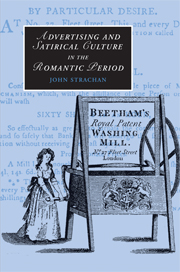Book contents
- Frontmatter
- Contents
- List of illustrations
- Acknowledgements
- Introduction
- 1 A ‘department of literature’: Advertising in the Romantic period
- 2 ‘Humbug and Co.’: Satirical engagements with advertising 1770–1840
- 3 ‘We keeps a poet’: Shoe blacking and the commercial aesthetic
- 4 ‘Publicity to a lottery is certainly necessary’: Thomas Bish and the culture of gambling
- 5 ‘Barber or perfumer’: Incomparable oils and crinicultural satire
- 6 ‘The poetry of hair-cutting’: J. R. D. Huggins, the emperor of barbers
- Conclusion: ‘Thoughts on puffs, patrons and other matters’: Commodifying the book
- Notes
- Bibliography
- Index
- CAMBRIDGE STUDIES IN ROMANTICISM
3 - ‘We keeps a poet’: Shoe blacking and the commercial aesthetic
Published online by Cambridge University Press: 22 September 2009
- Frontmatter
- Contents
- List of illustrations
- Acknowledgements
- Introduction
- 1 A ‘department of literature’: Advertising in the Romantic period
- 2 ‘Humbug and Co.’: Satirical engagements with advertising 1770–1840
- 3 ‘We keeps a poet’: Shoe blacking and the commercial aesthetic
- 4 ‘Publicity to a lottery is certainly necessary’: Thomas Bish and the culture of gambling
- 5 ‘Barber or perfumer’: Incomparable oils and crinicultural satire
- 6 ‘The poetry of hair-cutting’: J. R. D. Huggins, the emperor of barbers
- Conclusion: ‘Thoughts on puffs, patrons and other matters’: Commodifying the book
- Notes
- Bibliography
- Index
- CAMBRIDGE STUDIES IN ROMANTICISM
Summary
What though the gath'ring mire thy feet besmear,
The voice of industry is always near.
John Gay, Trivia (1716)BLACKING. An article prepared in various ways for the blacking of boots and shoes. Each manufacturer has his own recipe, in which the principal ingredients are oil, vinegar, and ivory-black, or some other sort of blacking matter. In former days shoe-blacks stood in our streets to perform the required operation on pedestrians, but in these days of improved pavements, and greater cleanliness, the brilliancy of the shoe that has received its morning polish at home, is scarcely impaired through the day. Blacking is either liquid or in the form of a paste, and some of the establishments for its manufacture, especially in London, are on the most extensive scale, and are known by their elaborate system of advertising all over the world.
Cyclopædia of Useful Arts, Mechanical and Chemical, Manufactures, Mining, and Engineering (1854)In The Tin Trumpet (1836), Horace Smith's whimsical commonplace book which was published under the pseudonym ‘Jefferson Saunders’, the entries for the letter ‘D’ begin thus:
DAY AND MARTIN – falsifiers of prophecy. Thirty years ago, our wiseacres predicted, that when all could read and write, we should find none to black our shoes. The day of evil has arrived; everybody can read and write; our shoes are not only better blacked than ever, but they are polished by comparatively polished people; our blacking-makers acquire fortunes, and build palaces, thus giving encouragement to other arts than the black one; and it is even reported, that a London firm keeps a regular bard upon the establishment, to write poetical puffs.
- Type
- Chapter
- Information
- Advertising and Satirical Culture in the Romantic Period , pp. 117 - 161Publisher: Cambridge University PressPrint publication year: 2007



